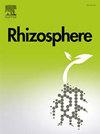树冠和根系对土壤水力学特性的综合影响:白杨的田间监测
IF 3.5
3区 生物学
Q1 PLANT SCIENCES
引用次数: 0
摘要
冠层和根系在调节土壤水力过程中起着至关重要的作用,但它们对土壤水力特性的综合影响尚不清楚。通过田间监测,研究了冠层截留、蒸腾和根系活动对白杨土壤水力学特性的综合影响。结果表明:生长期内叶片正面和背面接触角分别从104.3°和125.8°减小到75.1°和83.7°,导致冠层截流比显著增加;降雨期间,冠层截留和根系吸水限制了土壤含水量的增加和冠层下基质吸力的减少,但这种影响随着降雨量的增加而减弱。降雨后,蒸腾诱导的根系水分吸收加速了土壤水分的耗散和土壤基质吸力的恢复,分别与叶面积指数(LAI)呈指数和对数关系。冠层和根系对土壤水分和吸力的影响主要发生在6 ~ 10月LAI高值期,且主要发生在150cm土壤深度内。虽然根系活动通过提高孔隙度提高土壤饱和导水率,但在降雨前期高吸力条件下(60 kPa),冠层截留降低了土壤非饱和导水率。该研究强调了冠层和根系在调节土壤含水量、吸力和渗透性中的重要作用,对理解生态系统水文过程和指导生态修复具有重要意义。本文章由计算机程序翻译,如有差异,请以英文原文为准。
Combined effects of tree canopy and root systems on soil hydraulic properties: A field monitoring of a Populus alba
Canopy and roots play crucial roles in regulating soil hydraulic processes, yet their combined effects on soil hydraulic properties remain poorly understood. In this study, the combined effects of canopy interception, transpiration, and root activity on soil hydraulic properties were investigated through field monitoring of a Populus alba. The results showed that the contact angle on the adaxial and abaxial leaf surfaces decreased from 104.3° to 75.1° and from 125.8° to 83.7° during the growth period, respectively, resulting in a significant increase in the canopy interception ratio. During rainfall, canopy interception and root water uptake limited increases in soil water content and decreases in matric suction beneath the canopy, but this effect diminished with increasing rainfall. Following rainfall, transpiration-induced root water uptake accelerated the dissipation of soil water content and the recovery of soil matric suction, exhibiting exponential and logarithmic relationships with leaf area index (LAI), respectively. The influence of canopy and roots on soil water and suction is predominantly observed during the high LAI period from June to October and was primarily within 150 cm soil depth. Although root activity increased soil saturated hydraulic conductivity by improving porosity, canopy interception reduced unsaturated hydraulic conductivity under high soil suction conditions (>60 kPa) during early rainfall. This study highlights the critical role of the combined effects of canopy and roots in regulating soil water content, suction, and permeability, which have important implications for understanding ecosystem hydrological processes and guiding ecological restoration practices.
求助全文
通过发布文献求助,成功后即可免费获取论文全文。
去求助
来源期刊

Rhizosphere
Agricultural and Biological Sciences-Agronomy and Crop Science
CiteScore
5.70
自引率
8.10%
发文量
155
审稿时长
29 days
期刊介绍:
Rhizosphere aims to advance the frontier of our understanding of plant-soil interactions. Rhizosphere is a multidisciplinary journal that publishes research on the interactions between plant roots, soil organisms, nutrients, and water. Except carbon fixation by photosynthesis, plants obtain all other elements primarily from soil through roots.
We are beginning to understand how communications at the rhizosphere, with soil organisms and other plant species, affect root exudates and nutrient uptake. This rapidly evolving subject utilizes molecular biology and genomic tools, food web or community structure manipulations, high performance liquid chromatography, isotopic analysis, diverse spectroscopic analytics, tomography and other microscopy, complex statistical and modeling tools.
 求助内容:
求助内容: 应助结果提醒方式:
应助结果提醒方式:


